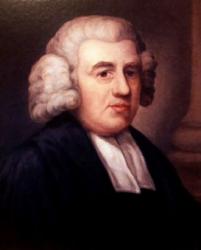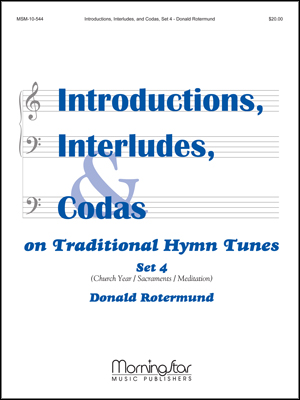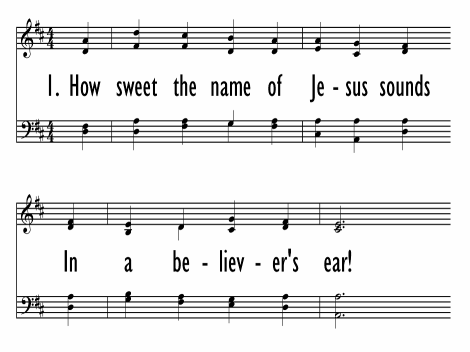- |
User Links
How Sweet the Name of Jesus Sounds

How sweet the name of Jesus sounds In a believer's ear
Author: John Newton (1779)Songs of Response
Published in 1630 hymnals
Printable scores: PDF, MusicXMLPlayable presentation: Lyrics only, lyrics + musicAudio files: MIDI, Recording
Representative Text
1 How sweet the name of Jesus sounds
in a believer's ear!
It soothes our sorrows, heals our wounds,
and drives away our fear.
2 It makes the wounded spirit whole
and calms the troubled breast;
'tis manna to the hungry soul,
and to the weary, rest.
3 O Jesus, shepherd, guardian, friend,
my Prophet, Priest, and King,
my Lord, my Life, my Way, my End,
accept the praise I bring.
4 How weak the effort of my heart,
how cold my warmest thought;
but when I see you as you are,
I'll praise you as I ought.
5 Till then I would your love proclaim
with every fleeting breath;
and may the music of your name
refresh my soul in death.
Psalter Hymnal, 1987
Author: John Newton
 John Newton (b. London, England, 1725; d. London, 1807) was born into a Christian home, but his godly mother died when he was seven, and he joined his father at sea when he was eleven. His licentious and tumultuous sailing life included a flogging for attempted desertion from the Royal Navy and captivity by a slave trader in West Africa. After his escape he himself became the captain of a slave ship. Several factors contributed to Newton's conversion: a near-drowning in 1748, the piety of his friend Mary Catlett, (whom he married in 1750), and his reading of Thomas à Kempis' Imitation of Christ. In 1754 he gave up the slave trade and, in association with William Wilberforce, eventually became an ardent abolitionist. After becoming a tide… Go to person page >
John Newton (b. London, England, 1725; d. London, 1807) was born into a Christian home, but his godly mother died when he was seven, and he joined his father at sea when he was eleven. His licentious and tumultuous sailing life included a flogging for attempted desertion from the Royal Navy and captivity by a slave trader in West Africa. After his escape he himself became the captain of a slave ship. Several factors contributed to Newton's conversion: a near-drowning in 1748, the piety of his friend Mary Catlett, (whom he married in 1750), and his reading of Thomas à Kempis' Imitation of Christ. In 1754 he gave up the slave trade and, in association with William Wilberforce, eventually became an ardent abolitionist. After becoming a tide… Go to person page >Text Information
Related Texts
| First Line: | How sweet the name of Jesus sounds In a believer's ear |
| Title: | How Sweet the Name of Jesus Sounds |
| Author: | John Newton (1779) |
| Meter: | 8.6.8.6 |
| Language: | English |
| Notes: | Spanish translation: See "Cuán dulce el nombre de Jesús" by Juan Bautista Cabrera Ivars; Swahili translation: See "Jina lake Yesu tamu" |
| Copyright: | Public Domain |
| Liturgical Use: | Songs of Response |
- (hymns)
- (hymns)
- (hymns)
- (hymns)
- (hymns)
- (hymns)
- (hymns)
- (hymns)
- (hymns)
- (hymns)
- (hymns)
- (hymns)
- (hymns)
- (hymns)
- (hymns)
- (hymns)
- (hymns)
- (hymns)
- (hymns)
- (hymns)
- (hymns)
- (hymns)
- (hymns)
- (hymns)
- (hymns)
- (hymns)
- (hymns)
- (hymns)
- (hymns)
- (hymns)
- (hymns)
- (hymns)
- (hymns)
- (hymns)
- (hymns)
- (hymns)
- (hymns)
- (hymns)
- (hymns)
- (hymns)
- (hymns)
- (hymns)
- (hymns)
- (hymns)
- (hymns)
- (hymns)
- (hymns)
- (hymns)
- (hymns)
- (hymns)
- (hymns)
- (hymns)
- (hymns)
- (hymns)
- (hymns)
- (hymns)
- (hymns)
- (hymns)
- (hymns)
- (hymns)
- (hymns)
- (hymns)
- (hymns)
- (hymns)
- (hymns)
- (hymns)
- (hymns)
- (hymns)
- (hymns)
- (hymns)
- (hymns)
- (hymns)
- (hymns)
- (hymns)
- (hymns)
- (hymns)
Chinese
English
- A Baptist Hymn Book, Designed Especially for the Regular Baptist Church and All Lovers of Truth #d328
- A Book of Worship for the Use of the Evangelical Lutheran Church ... of the Church of the Redeemer, Richmond, Virginia #d57
- A Choice Collection of Hymns, in which are some never before printed #CXII
- A Choice Selection of Hymns and Spiritual Songs for the use of the Baptist Church and all lovers of song #32
- A Choice Selection of Hymns and Spiritual Songs, Designed to Aid in the Devotions of Prayer, Conference, and Camp-Meetings #63
- A Choice Selection of Hymns. 2nd ed. #d95
- A Choice Selection of Hymns. 6th ed. #d116
- A Choice Selection of Psalms, Hymns and Spiritual Songs for the use of Christians #103
- A Chord #d39
- A Church Hymn Book: for the use of congregations of the United Church of England and Ireland #133 10 shown out of 1067
French Creole
Spanish
Swedish
Welsh
Notes
Scripture References:
st. 1 = Acts 4:12, Jer.30:17, Rom. 10:13, Joel 2:32, 1 John 4:18, Ps.147:3
st. 2 = John 16:20, John 6:31-33, Matt. 11:28
st. 3 = John 10:11, John 15:13-14, John 4:19, John 14:6, Heb.4:14, Rev. 17:14
With the heading “The Name of Jesus,” this text by John Newton (PHH 462) was pub1ished in the Olney Hymns (1779), where it was part of a group of hymns inspired by scriptural passages. The text is a fine example of Newton's evangelical piety and his skill at incorporating biblical phrases or allusions into his hymn texts. Of his original seven stanzas, 1, 2, and 5-7 are included.
Newton said that Song of Songs 1:3 ("your name is like perfume poured out") was the inspiration for this text: stanzas 1 and 2 compare perfume, with its sweet fragrance and healing properties, to the name of Jesus, which "soothes" and "heals." With its many biblical names for the Savior, stanza 3 evokes a variety of images about the person and ministry of Christ. The final stanzas confess that though our worship of Christ may be weak and imperfect, we will use our resources to praise him and testify to his love.
Liturgical Use:
Many occasions of worship, probably after the sermon as a hymn of testimony and encouragement.
--Psalter Hymnal Handbook, 1988
Tune
ST. PETER (Reinagle)Composed by Alexander R. Reinagle (b. Brighton, Sussex, England, 1799; d. Kidlington, Oxfordshire, England, 1877), ST. PETER was published as a setting for Psalm 118 in Reinagle's Psalm Tunes for the Voice and Pianoforte (c. 1836). The tune first appeared with Newton's text in Hymns Ancient and Mode…
ORTONVILLE
For Leaders
Text:
John Newton wrote this hymn and published it in his Olney Hymns in 1779 under the title “The Name of Christ.” It was included in the first book of that collection, which was titled “On Select Texts of Scripture.” Song of Solomon 1:3 was the text on which this hymn in seven stanzas was based.
Two of the original seven stanzas are always included: the first (“How sweet the name…”) and the original fifth (“Jesus! My Shepherd, …”). The original fourth stanza (“By thee my prayers…”) is nearly always omitted in modern hymnals, except when all seven stanzas are included. Hymnals vary as to which of the remaining four stanzas are omitted.
The opening line of the original fifth stanza has been a problem for hymnal editors because of Newton's use of the word “Husband” (the original version was “Jesus! My Shepherd, Husband, Friend”). His word choice makes sense if viewed in light of the long tradition of reading Song of Solomon as an allegory for the love between Christ and the Church, His Bride. However, hymnal editors have generally found it awkward for congregational use, and have found a substitute word for “husband.” Common choices are “guardian” or “brother.”
The first stanzas of the hymn focus on the soothing power of the name of Jesus. The stanza beginning “Jesus, my shepherd, guardian, friend” is a list of some of Christ's other names. The remaining stanzas speak of the relationship between Christ and the Christian.
Tune:
Alexander Reinagle was organist at the Church of St. Peter's in the East in London from 1822 to 1853. His tune ST. PETER was named for that church and was first published in Reinagle's Psalm Tunes for Voice and Piano Forte in 1830. He later harmonized it for Hymns Ancient and Modern in 1861. This hymn tune can be sung in harmony or in unison. It is not a showy tune, but is best suited for plain singing and accompaniment that allows the text to be the focus.
When/Why/How:
This hymn is a song of response, and would work well after the sermon. An organ introduction for ST. PETER is included in “Introductions, Interludes, and Codas, Set 4.” A piano setting of ST. PETER that could be used for a postlude is part of the collection “Surrender.”
Tiffany Shomsky, Hymnary.org
Timeline
Arrangements
Media
- MIDI file from Baptist Hymnal 1991 #453
- MIDI file from Baptist Hymnal 1991 #453
- Audio recording from Baptist Hymnal 2008 #323
- MIDI file from The Christian Sunday School Hymnal: a compilation of choice hymns and tunes for Sunday schools #29
- MIDI file from The Cyber Hymnal #2630
- Audio recording from Evangelical Lutheran Worship #620
- Audio recording from Lift Up Your Hearts: psalms, hymns, and spiritual songs #453
- Audio recording from Psalter Hymnal (Gray) #487
- MIDI file from Psalter Hymnal (Gray) #487
- MIDI file from Psalter Hymnal (Gray) #487
- MIDI file from Redemption Songs: a choice collection of 1000 hymns and choruses for evangelistic meetings, solo singers, choirs and the home #322b
- Audio recording from Small Church Music #65
- Audio recording from Small Church Music #65
- Audio recording from The Southern Harmony, and Musical Companion (New ed. thoroughly rev. and much enl.) #12
- MIDI file from The Southern Harmony, and Musical Companion (New ed. thoroughly rev. and much enl.) #12
- MIDI file from Songs of Love and Praise No. 4 #219
- Audio recording from Trinity Hymnal (Rev. ed.) #647


 My Starred Hymns
My Starred Hymns






